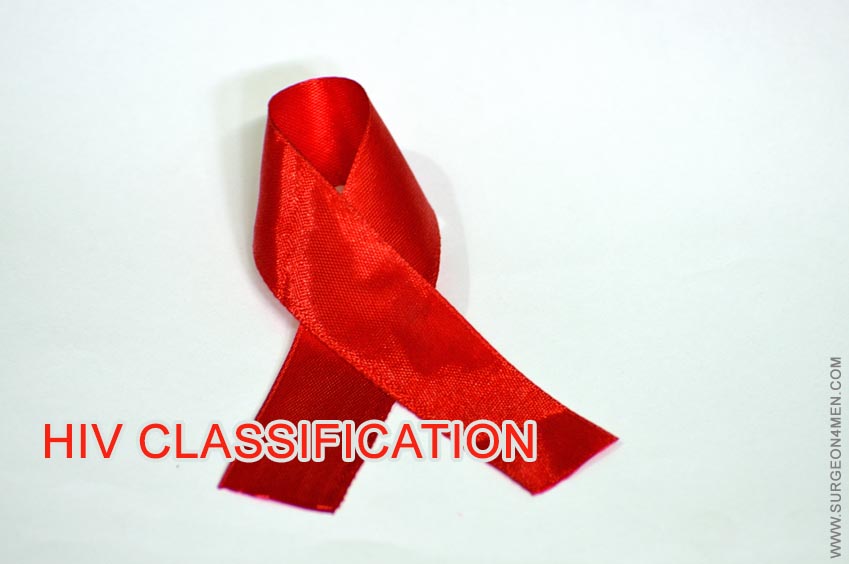Human Immunodeficiency Virus (HIV) | History and Classification
There are two main reasons why HIV disease needs to be classified. They are:
- For monitoring the HIV epidemic worldwide
- For the clinical management of the patients
At present, two methods of classification are followed around the world. They are
- The CDC disease staging system
- The WHO Clinical Staging and Disease Classification System
The CDC Disease Staging System for HIV Infection
 The CDC system was last revised in 1993. This system is dependent upon the CD4 cell count of the affected individual. The severity of the condition is assessed on the basis of CD4 counts and presence of certain HIV related conditions. This system is more useful for epidemiological and clinical research. According to it, a person is said to be suffering from AIDS if his CD4 count is less than 200cells/µL of blood. The category of the patient cannot be revised at a later stage even if his symptoms improve subsequently. This is the single major drawback of this classification.
The CDC system was last revised in 1993. This system is dependent upon the CD4 cell count of the affected individual. The severity of the condition is assessed on the basis of CD4 counts and presence of certain HIV related conditions. This system is more useful for epidemiological and clinical research. According to it, a person is said to be suffering from AIDS if his CD4 count is less than 200cells/µL of blood. The category of the patient cannot be revised at a later stage even if his symptoms improve subsequently. This is the single major drawback of this classification.
The WHO Clinical Staging and Disease Classification System
The WHO system is based on the clinical manifestations of the condition. As it is not dependent upon the CD4 cell count, it is helpful to the physicians in settings where laboratory testing methods are not available. The doctors can easily classify the stage and give treatment accordingly. Clinicians with different levels of HIV expertise can treat patients even in resource-constrained places. According to this system, the infection is classified under 4 stages ascending from primary HIV infection to advanced AIDS.
History of HIV infection
The natural history of HIV infection which is left untreated, involves three important landmarks. They are:
Primary HIV Infection
It is the time period between initial infection with HIV and the development of antibodies in the patient as detected by standard blood tests. According to statistics available, almost 87% of people show some symptoms of primary HIV infection. These symptoms include fever, fatigue, enlargement of lymph nodes, headache and development of maculopapular rashes on the trunk. In some cases, joint pains, pharyngitis, mucosal candidiasis and night sweats are also observed. As these symptoms are non-specific, only 25% of the cases get diagnosed at this stage. However, if the physician is suspicious, he can ask for HIV RNA assays as the plasma viral load is unusually high. CD4 counts usually decline during this stage. They may rebound but never reach their earlier levels. The primary HIV infection usually lasts for 2 weeks.
Chronic HIV Infection
 After the primary phase is over, the viral replication in the host and his immune reaction attain some sort of equilibrium. This period may last for as long as ten years during which the patient remains more or less asymptomatic. However, this doesn’t mean that the viral replication and CD4 cell turnover comes to a halt. The CD4 counts fall by 50-90 cells/µL/year and as the time elapses, this rate of fall accelerates. During this phase, the higher the plasma viral load, the faster is the progression to AIDS.
After the primary phase is over, the viral replication in the host and his immune reaction attain some sort of equilibrium. This period may last for as long as ten years during which the patient remains more or less asymptomatic. However, this doesn’t mean that the viral replication and CD4 cell turnover comes to a halt. The CD4 counts fall by 50-90 cells/µL/year and as the time elapses, this rate of fall accelerates. During this phase, the higher the plasma viral load, the faster is the progression to AIDS.
Clinical AIDS
According to CDC, a patient is said to be suffering from clinical AIDS when his CD4 count is less than 200 cells/µL. Certain specific conditions which define AIDS as per the WHO classification develop two years after the fall in the CD4 count. These include HIV wasting syndrome, Pneumocystis pneumonia, esophageal candidiasis, Kaposi sarcoma, HIV encephalopathy, Cytomegalovirus infection, extra-pulmonary tuberculosis, non-tuberculous disseminated mycobacterial infection, etc. The mean survival period after development of clinical AIDS, in the absence of retroviral drugs, is 10 to 12 months.
Reference:

